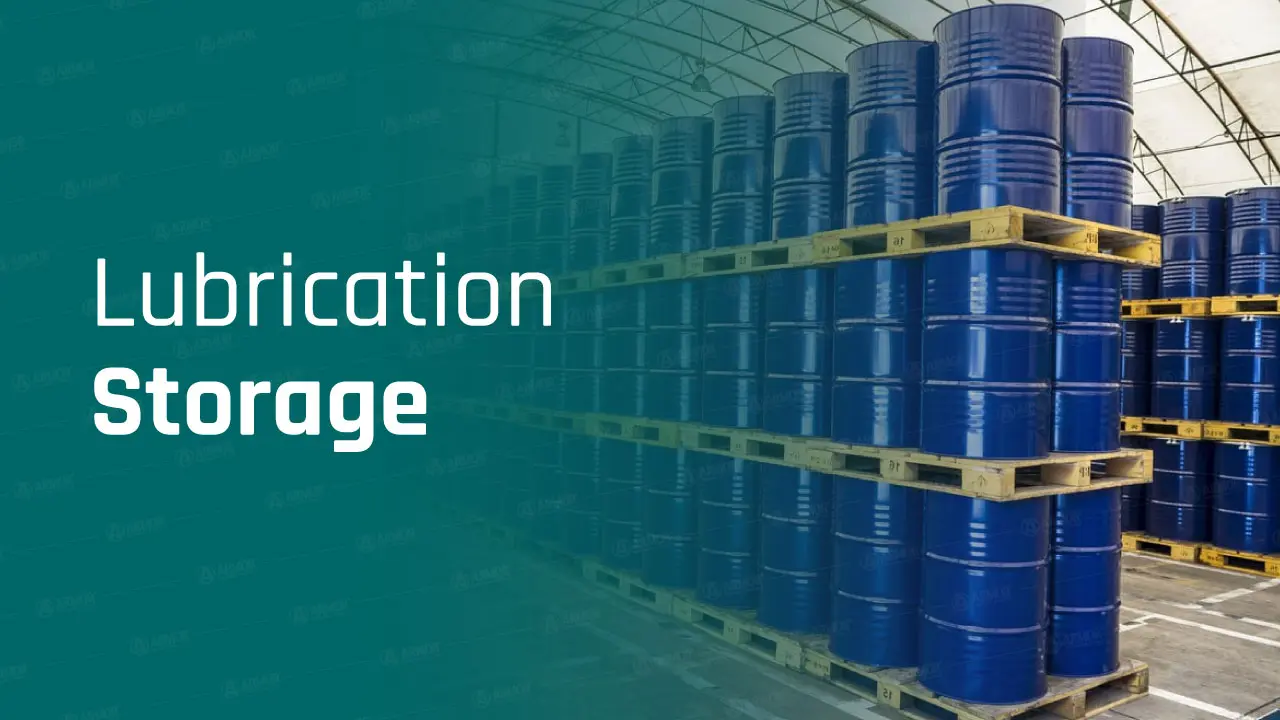- Armor Blog
- Consumer Education
- Lubrication Storage Tips to Prevent Machine Failure

Choosing the Right Lubrication Storage Containers
Selecting the appropriate storage containers for machinery lubricants is crucial for maintaining their effectiveness and extending the life of your machines. The right containers can prevent contamination, degradation, and spillage, ensuring that your machinery oils are always ready for use.
Types of Lubrication Storage Containers
Different types of containers are suited for various lubricant for machines:
- Drums: Ideal for bulk storage of machinery oils. Ensure drums are sealed properly to prevent contamination.
- Totes: Large containers suitable for facilities that use high volumes of lubricants. They offer better handling and dispensing options.
- Portable Containers: These are smaller, easy-to-handle containers for day-to-day use. They help in reducing the risk of spills and contamination during transfer.
Benefits of Proper Storage Containers
Using the right storage containers for machinery lubricants offers several advantages:
- Prevents Contamination: Properly sealed containers keep out dust, dirt, and moisture, which can degrade the lubricant quality.
- Enhances Safety: Reduces the risk of spills and accidents, ensuring a safer working environment.
- Improves Efficiency: Easy-to-handle containers make it quicker to dispense and apply lubricants, reducing downtime.
Common Mistakes in Storage Container Selection
Avoid these common errors when selecting storage containers for machinery oil:
- Using Non-Compatible Materials: Some materials can react with lubricants, causing contamination or degradation. Always use containers made from compatible materials.
- Improper Sealing: Ensure that containers are always tightly sealed to prevent air and moisture ingress.
- Ignoring Labeling: Failing to label containers correctly can lead to the use of incorrect lubricants, resulting in machinery damage.
Ideal Lubricant Storage Conditions
Maintaining the optimal storage conditions for machinery lubricants is essential for preserving their quality and effectiveness. Proper storage conditions help in preventing degradation and contamination, ensuring that your lubricants remain in peak condition for machine health.
Optimal Temperature for Lubricant Storage
Temperature plays a critical role in the longevity of machinery oil:
- Cool and Consistent: Store lubricants in a cool, consistent environment to prevent thermal degradation. Extreme temperature fluctuations can lead to the breakdown of lubricant properties.
- Avoid Heat Sources: Keep storage containers away from direct sunlight, heaters, and other heat sources to prevent overheating and evaporation.
- Insulated Storage Areas: Consider using insulated storage rooms or cabinets to maintain a stable temperature, especially in areas with extreme weather conditions.
Managing Humidity Levels
Humidity can have a detrimental effect on lubricant for machines:
- Low Humidity Environment: High humidity levels can cause moisture ingress, leading to rust and contamination. Aim to keep storage areas as dry as possible.
- Desiccant Packs: Use desiccant packs in storage areas to absorb excess moisture and protect lubricants from humidity.
- Proper Ventilation: Ensure that storage areas are well-ventilated to prevent the buildup of moisture and condensation.
Protecting Lubricants from Contaminants
Contaminants can compromise the performance of machinery lubricants:
- Sealed Containers: Always keep lubricant containers tightly sealed when not in use to prevent dust, dirt, and other contaminants from entering.
- Clean Storage Areas: Regularly clean and maintain storage areas to minimize the presence of contaminants. Avoid storing lubricants near chemicals or substances that could cause contamination.
- Dedicated Storage: Use dedicated storage spaces for lubricants, separate from other maintenance supplies, to reduce the risk of cross-contamination.
Organization and Labeling
Effective organization and labeling of machinery lubricants are critical for ensuring that the right lubricant is always available when needed. Proper practices in this area help prevent mix-ups, reduce waste, and enhance the efficiency of maintenance operations.
Effective Labeling Practices
Clear and accurate labeling of machinery oil containers is essential:
- Color-Coding: Use a color-coding system to differentiate between various types of lubricants. This makes it easy to identify the correct lubricant for machines at a glance.
- Detailed Labels: Include essential information on the labels such as the type of lubricant, date of purchase, and expiration date. This helps in monitoring the age and usability of the lubricant.
- Standardized Labels: Implement standardized labels across all storage containers to maintain consistency and reduce confusion among maintenance personnel.
Organizing Storage for Easy Access
Proper organization of machinery lubricants ensures quick and easy access:
- Categorize by Type: Group lubricants by their type and application. For example, keep all hydraulic oils in one section and all engine oils in another.
- Shelf Organization: Arrange lubricants on shelves in a systematic manner, with frequently used lubricants placed at eye level for easy reach.
- FIFO Method: Follow the First In, First Out (FIFO) method to use older lubricants first. This helps in reducing the chances of lubricant degradation over time.
Inventory Management Tips
Maintaining an accurate inventory of machinery oil is crucial for efficient operations:
- Regular Audits: Conduct regular inventory audits to keep track of lubricant quantities and ensure that stock levels are adequate.
- Inventory Software: Utilize inventory management software to monitor lubricant usage and stock levels. This can help in forecasting future needs and preventing stockouts.
- Restock Alerts: Set up alerts for when lubricant levels are running low, ensuring timely reordering and avoiding any disruptions in maintenance schedules.
Regular Maintenance of Stored Lubricants
Regular maintenance of stored machinery lubricants is vital to preserve their quality and ensure they perform effectively when used. Routine inspections and proper disposal practices are key to maintaining lubricant integrity and prolonging machinery life.
Routine Inspections and Quality Checks
Frequent checks help maintain the quality of machinery oil:
- Visual Inspections: Regularly inspect lubricant containers for signs of contamination, such as discoloration, cloudiness, or sediment. Early detection of issues can prevent further degradation.
- Sampling and Testing: Periodically take samples of stored lubricants and conduct tests to check for contamination and degradation. This ensures that only high-quality lubricants are used in machinery.
- Check Seals and Labels: Ensure that all containers are properly sealed and that labels remain legible and accurate over time. Replace any damaged seals or labels immediately.
Signs of Lubricant Degradation
Recognizing degradation signs in lubricant for machines is crucial:
- Changes in Color and Odor: Any unusual color changes or strong odors can indicate that the lubricant has degraded and may not perform effectively.
- Separation of Components: If you notice separation of oil and additives, it suggests that the lubricant is breaking down and may need to be replaced.
- Consistency Changes: Thicker or thinner consistency than usual can signal that the lubricant’s properties have altered, affecting its performance.
Proper Disposal of Expired Lubricants
Disposing of expired machinery lubricants correctly prevents environmental harm and maintains safety:
- Follow Regulations: Adhere to local regulations and guidelines for disposing of used or expired lubricants. This ensures compliance and environmental protection.
- Use Authorized Disposal Services: Engage with authorized disposal services to handle the disposal of lubricants. These services have the necessary expertise and facilities to manage lubricant waste safely.
- Document Disposal: Keep records of lubricant disposal to track and verify that it has been conducted responsibly. This documentation can be useful for audits and regulatory compliance.
Contact Armor Lubricants for Expert Lubrication Solutions
Armor Lubricants is a leading lubricants company in UAE, dedicated to providing top-quality lubrication solutions for a wide range of industrial applications. Our commitment to excellence and innovation makes us the preferred choice for businesses seeking reliable and effective lubricants.
Customized Lubrication Solutions
As a premier lubricant manufacturing company in UAE, Armor Lubricants offers customized solutions to meet your specific needs:
- Tailored Formulations: We develop specialized formulations tailored to the unique requirements of your machinery and operational conditions, ensuring optimal performance and longevity.
- Comprehensive Product Range: Our extensive product range includes hydraulic oils, gear oils, engine oils, and more, designed to meet the demands of various industries.
- Technical Support: Our team of experts provides technical support and guidance to help you select the right lubricants and implement best practices for their use.
Quality and Reliability
As one of the top industrial lubricants manufacturers in UAE, Armor Lubricants guarantees high-quality lubricants and services:
- Advanced Manufacturing: Utilizing state-of-the-art manufacturing facilities, we produce lubricants that meet the highest standards of quality and performance.
- Stringent Quality Control: Our rigorous quality control processes ensure that every batch of lubricant we produce delivers consistent and reliable results.
Learn More about the Impact of Lubrication on Machine Health here.




 Spear Lubricants
Spear Lubricants Armada lubricant
Armada lubricant Ace lubricants
Ace lubricants Perfect lubricants
Perfect lubricants Enzo lubricants
Enzo lubricants Lawrence lubricants
Lawrence lubricants